Common Causes of a Clogged Sewer Line and How to Prevent It
By Brian on August 25, 2025
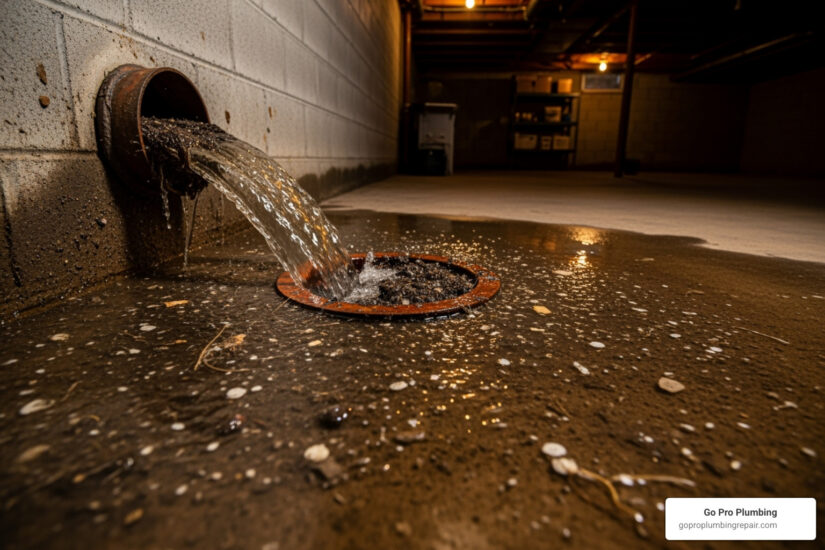
Why a Sewage Line Clogged Issue Needs Immediate Attention
A sewage line clogged problem is one of the most serious plumbing emergencies a homeowner can face. When your main sewer line backs up, it affects your entire home’s drainage system and can create serious health hazards.
Quick Answer for Sewage Line Clogs:
- Multiple drains backing up = Main sewer line issue
- Single drain slow = Branch drain problem
- Water backing up when toilet flushes = Sewer blockage
- Sewage smell throughout house = Major clog or break
- Soggy yard without rain = Possible sewer leak
Immediate Actions:
- Stop all water use immediately
- Turn off main water supply
- Call a professional plumber – don’t attempt DIY fixes
- Check with neighbors to rule out city main issues
Unlike a simple drain clog that affects one fixture, a main sewer line blockage impacts your entire plumbing system. According to plumbing industry data, homeowners can expect to pay between $1,200 and $6,000 to repair or replace a sewer line, making prevention and early detection crucial.
The main causes include grease buildup, “flushable” wipes, tree root intrusion, and aging pipes. In Northern California, tree roots are especially problematic due to the region’s mature landscaping and older sewer systems.
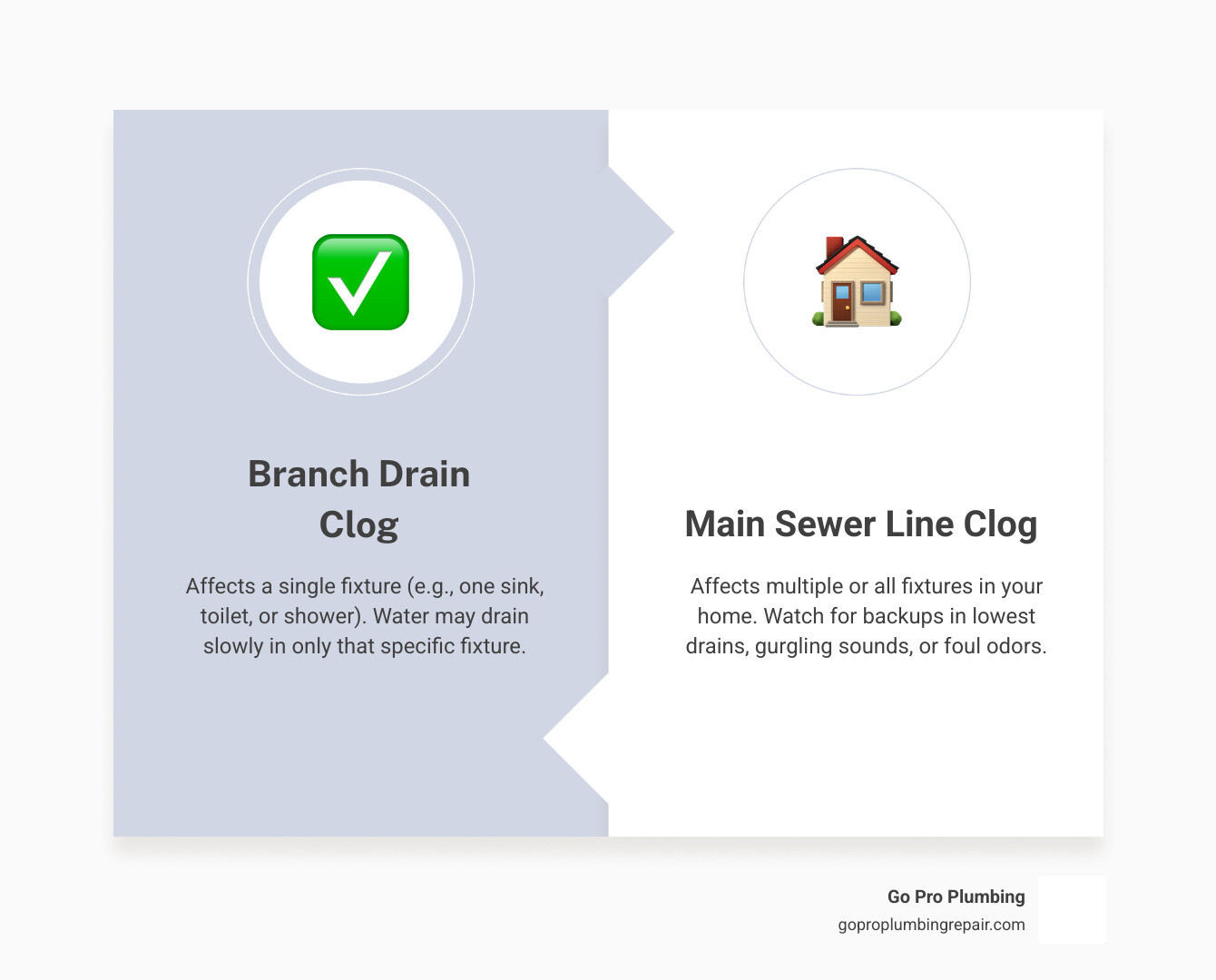
Sewage line clogged word roundup:
Is Your Main Sewer Line Clogged? Key Warning Signs
If you flush a toilet upstairs and water backs up in your basement shower, your home’s plumbing is waving a red flag that screams “sewage line clogged!” The difference between a simple drain clog and a main sewer line problem is significant. When just one fixture acts up, it’s likely a branch drain issue. But when multiple drains start misbehaving together, your main sewer line is the probable culprit.
Here’s how to tell what you’re dealing with:
| Symptom | Single Drain Clog | Main Sewer Line Clog |
|---|---|---|
| Affected Fixtures | Only one sink, toilet, or shower | Multiple fixtures throughout your home |
| Drainage Speed | Slow in just that one fixture | Sluggish draining everywhere |
| Sounds | Maybe a gurgle from that one drain | Weird gurgling from multiple places |
| Smells | Funky odor from one specific drain | Sewer smell wafting through the house |
| Backup Patterns | Water backs up only where the clog is | Lower-level fixtures overflow when you use upper ones |
| Cleanout Pipe | Stays clear | May have standing sewage (yuck!) |
Catching these warning signs early can save you from a messy, expensive nightmare. The longer a sewage line clogged situation goes untreated, the worse it gets – and the more it’ll cost to fix. For a deeper dive into identifying blockages, check out our guide on Sewer Line Blockage.
Multiple Drains Are Backing Up
When multiple fixtures act up at once, you likely have a main sewage line clogged. The telltale sign is multiple drains going haywire simultaneously. It usually starts with the lowest-level fixtures because water follows gravity. For instance, flushing an upstairs toilet might cause water to bubble up in a basement floor drain. Running your washing machine or dishwasher could cause a first-floor toilet to overflow. Since toilets, showers, bathtubs, and sinks all connect to your main line, a blockage there affects them all.
Strange Noises, Smells, and Slow Draining
Your plumbing system has its own way of calling for help – through weird sounds and nasty smells that make you go “hmm, that’s not right.”
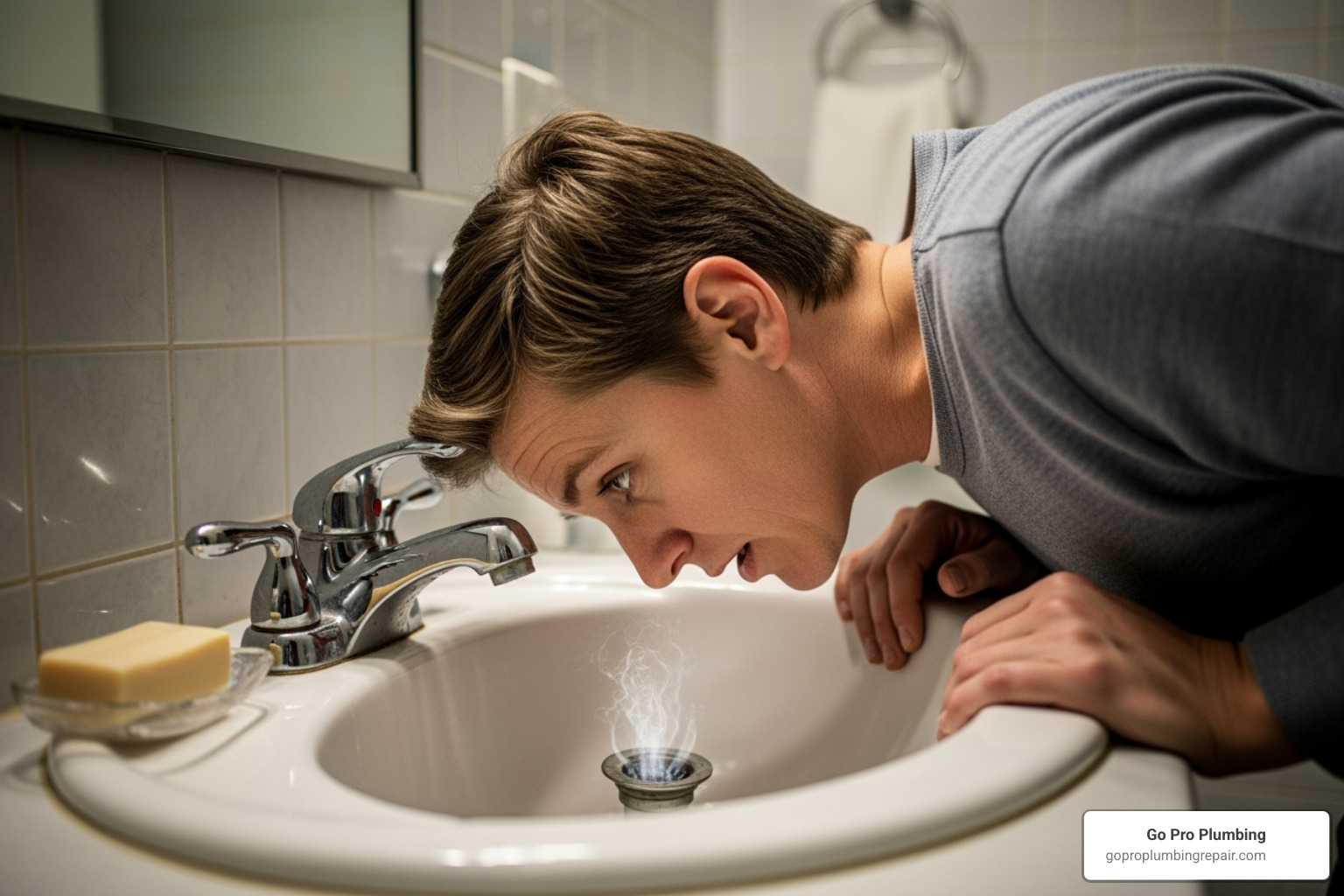
Ever heard your toilet making gurgling sounds when you’re not even using it? Or noticed bubbling toilet water that looks like a science experiment gone wrong? These are distress signals. When air gets trapped because of a blockage, it has to escape somewhere, creating those unsettling gurgles and bubbles.
A persistent sewer gas smell throughout your house isn’t something you can ignore with air fresheners. This isn’t just unpleasant – it’s actually dangerous. Sewer gas contains harmful bacteria and can make you sick.
And then there’s the slow drainage issue. When every sink, tub, and shower in your house starts draining like molasses, your main sewer line is struggling. One slow drain might just need a good snake, but when everything’s moving at a snail’s pace, you’ve got a sewage line clogged situation that needs professional attention.
Outdoor Clues and Differentiating Clog Types
Sometimes your yard tattles on your sewer line before your indoor plumbing does. A soggy yard when it hasn’t rained is like your lawn sending up a flare gun – something’s not right underground.
Even sneakier is when you notice unusually green patches of grass above where your sewer line runs. While you might think your lawn is just being extra healthy, it’s actually getting fertilized by leaking sewage. Not exactly the kind of organic gardening you want.
Your sewer cleanout pipe is like having a direct hotline to your main sewer line. This capped pipe (usually white or black) sits outside your home or in your basement. If you carefully remove the cap and find sewage standing there or flowing out, you’ve got confirmation that your main line is blocked.
It’s important to know the difference between a clogged line versus a broken one. A clog means something’s stuck; a break means your pipe is physically damaged. Broken lines can cause sinkholes, attract pests, and create ongoing problems that get worse over time.
Here’s something crucial: you need to figure out if this is your problem or the city’s. Generally, you’re responsible for the sewer line from your house to the street connection. If your neighbors are having similar issues, it might be the city main that’s backed up. A quick chat with the folks next door can save you a service call.
For detailed troubleshooting steps, the city of Seattle has put together a helpful resource: Troubleshooting Your Sewer Problem: Dealing With Sewer Backups.
The Culprits: Common Causes of a Clogged Sewer Line
Nobody wakes up thinking, “I wonder how I can clog my sewer line today!” Yet somehow, these blockages happen to thousands of homeowners every year. Most sewage line clogged situations develop gradually through our everyday habits, combined with forces beyond our control.
Think of your sewer line like your arteries – small deposits build up over time until suddenly, you have a major blockage. The good news? Understanding what causes these clogs is your first line of defense against expensive repairs.
Everyday Buildup from Sinks and Drains
Your kitchen sink is often ground zero for sewer line problems, with the biggest villain being Fats, oils, and grease (FOG). When you pour hot grease down the drain, it cools and solidifies into a sticky mass that traps soap scum and food particles. Your garbage disposal can also contribute if misused. Fibrous materials like celery and starchy foods like pasta can create paste-like clogs downstream. In Northern California’s older homes, scale buildup in aging pipes is another factor. Mineral deposits create a rough surface inside pipes, which snags debris and accelerates clog formation.
Flushing Faux Pas: What Not to Put Down the Toilet
Here’s where things get really frustrating for homeowners. You’d think something labeled “flushable” would be safe to flush, right? Wrong! “Flushable” wipes are one of the leading causes of sewer line blockages, despite their misleading name.
Unlike toilet paper, which breaks apart quickly in water, these wipes stay intact. They clump together in your pipes, creating massive blockages that can extend 30 feet or more through your sewer line. It’s like stuffing wet towels down your toilet.
But wipes aren’t the only problem. Feminine hygiene products, paper towels, cotton swabs, and dental floss all spell trouble for your sewer system. Even something as thin as dental floss can snag on pipe joints or rough spots, creating a net that catches other debris.
The golden rule? Only toilet paper and human waste should go down your toilet. Everything else belongs in the trash, no matter how convenient flushing might seem.
External Forces and Pipe Degradation
Sometimes the cause of your sewage line clogged problem has nothing to do with what you’re putting down the drains. Mother Nature and Father Time can be just as destructive.
Tree root intrusion is especially common in Northern California, where mature landscaping and older sewer systems create the perfect storm. Tree roots are incredibly persistent – they can detect moisture from tiny cracks in your pipes and will grow toward that water source like a heat-seeking missile.
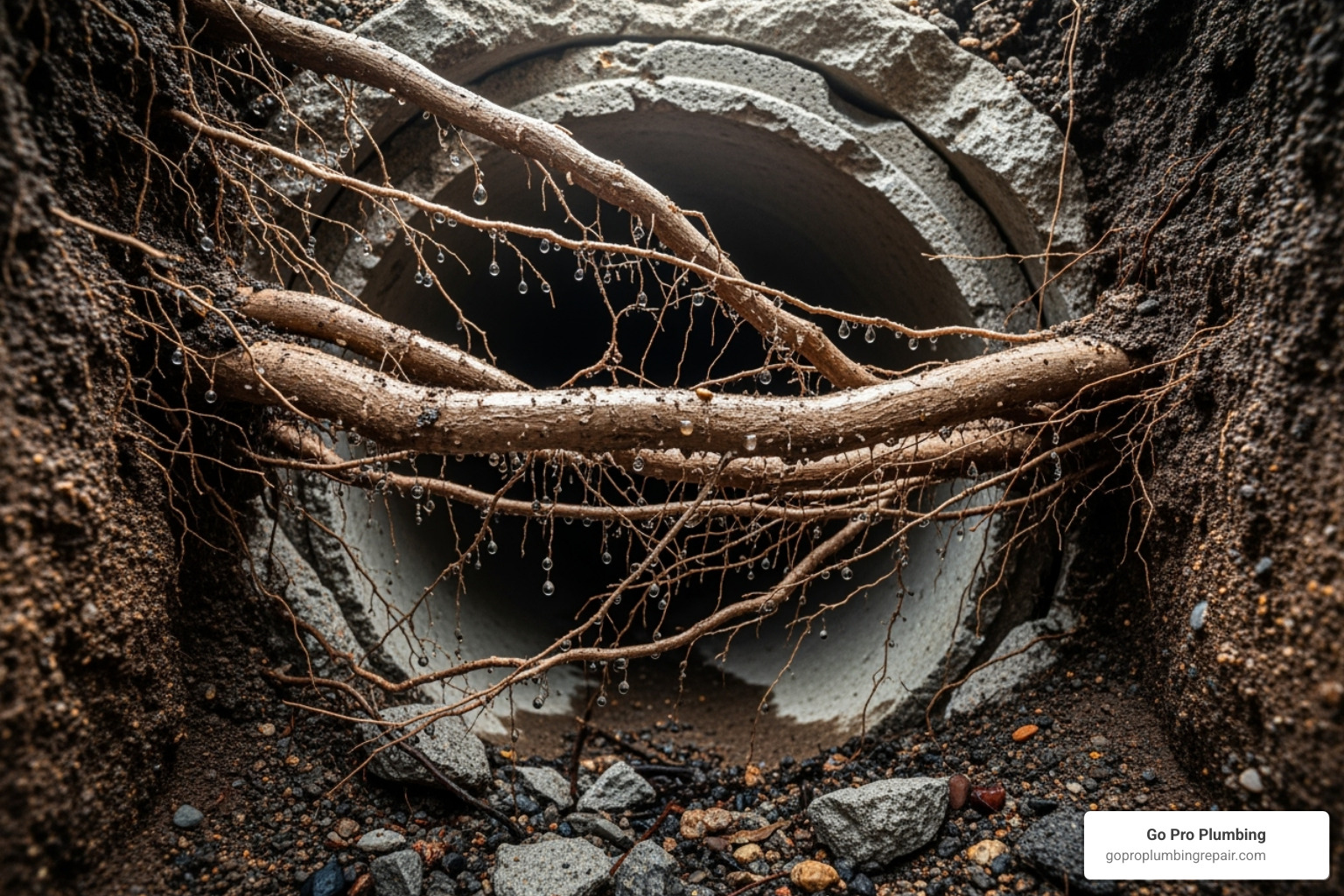
Once roots find their way into your sewer line, they don’t just create a blockage – they throw a party. They grow into dense root balls that can completely obstruct your pipe and eventually cause it to crack or collapse entirely.
Shifting soil from heavy rains or ground movement can cause pipes to sag, creating low spots called “bellies” where waste and debris collect. Meanwhile, old pipe materials like clay and cast iron simply wear out over time. Clay pipes become brittle and crack, while cast iron corrodes from the inside out.
When pipes are severely damaged by roots or age, traditional repair methods might not be enough. That’s when we often recommend Trenchless Sewer Replacement, which can replace your entire sewer line without turning your beautiful yard into an archaeological dig site.
The reality is that some causes of sewer line clogs are unavoidable – trees will always seek water, and pipes will eventually age out. But understanding these causes helps you make informed decisions about maintenance and repairs before a small problem becomes a big, expensive mess.
Your Immediate Action Plan for a Suspected Clog
When you suspect a sewage line clogged situation, your next few moves can make the difference between a manageable repair and a full-blown plumbing disaster. Don’t panic, but do act quickly. The longer sewage sits in your pipes and potentially backs up into your home, the more damage it can cause – and the more expensive your cleanup bill becomes.
Think of it this way: every minute you delay is like leaving a faucet running in a room that’s already starting to flood. The key is stopping the flow immediately and getting professional help. Our team at Go Pro Plumbing has seen what happens when homeowners wait “just to see if it gets better” – spoiler alert, it never does. That’s why we offer Sewer and Drain Emergency Services for exactly these urgent situations.
Step 1: Stop All Water Use Immediately
When dealing with a sewage line clogged emergency, every drop of water sent down your drains works against you. Turn off your main water supply to prevent anyone from accidentally making the situation worse. Do not flush toilets, run sinks or showers, or use your washing machine or dishwasher. Even a few seconds of running water can cause more sewage to back up into your home. The temporary inconvenience of stopping water use is minor compared to the nightmare of a full-blown sewage backup, which can require extensive services like Cleaning Basement After Sewer Backup.
Step 2: Locate Your Sewer Cleanout
Now that you’ve stopped the flow of water, it’s time to play detective. Your sewer cleanout pipe is like a window into what’s happening with your main sewer line, and checking for standing water can tell you a lot about where the problem is located.
Most cleanouts are located in your basement or outdoor location near your home’s foundation. Look for a white PVC or black cast iron pipe with a removable cap. If you’re not sure where yours is, don’t worry – many homeowners have never had to think about it before.
Carefully remove the cap (it might be screwed on or just pushed in place). If sewage or standing water flows out, you’ve confirmed that the blockage is in your main line, past the cleanout. If the cleanout is dry, the clog is likely between your house and the cleanout – still serious, but potentially easier to access.
This is also a good time to check with neighbors about whether they’re experiencing similar issues. If multiple homes on your street are having problems, it might be a city main line issue, which changes who’s responsible for the fix. Generally speaking, homeowner vs. city responsibility is divided at the connection point to the municipal system – you own and maintain everything from your house to that connection point.
Step 3: Understand the Health Risks and Avoid DIY Mistakes
Here’s where we need to have a serious conversation about safety. A sewage line clogged situation isn’t just gross – it’s genuinely dangerous. Raw sewage contains bacteria and viruses that can make you seriously ill, and the longer it sits, the higher the risk of mold growth throughout your home.
Sewer gas exposure is another concern that many homeowners don’t realize. Those foul smells aren’t just unpleasant; they can cause headaches, nausea, and in extreme cases, more serious health problems. According to research on Drainage Systems, an Occluded Source of Sanitation Related Outbreaks, drainage issues can be significant sources of health hazards that are often overlooked.
Now, we understand the urge to grab some drain cleaner and try to fix this yourself – we really do. But please resist that impulse. Chemical drain cleaners are not only ineffective against main sewer line clogs, they can actually make the problem worse by damaging your pipes. Plus, if you call a professional after using chemicals, you’re putting the technician at risk of exposure to dangerous fumes.
The potential for pipe damage from DIY attempts is real. Home drain snakes aren’t designed for main sewer lines, and using the wrong tools can turn a simple clog into a broken pipe situation. We’ve seen homeowners turn a $300 drain clearing into a $3,000 pipe replacement because they tried to handle it themselves first.
When you’re dealing with a sewage line clogged emergency, the smartest move is always to call professionals who have the right equipment, safety gear, and experience to handle it safely and effectively.
Professional Solutions and Prevention for a Clogged Sewer Line
When you’re facing a sewage line clogged emergency, you need professionals who understand the urgency and have the right tools to get your life back to normal quickly. Here in Northern California, our Go Pro Plumbing team has seen it all – from simple blockages to complex root invasions that have been building for years.
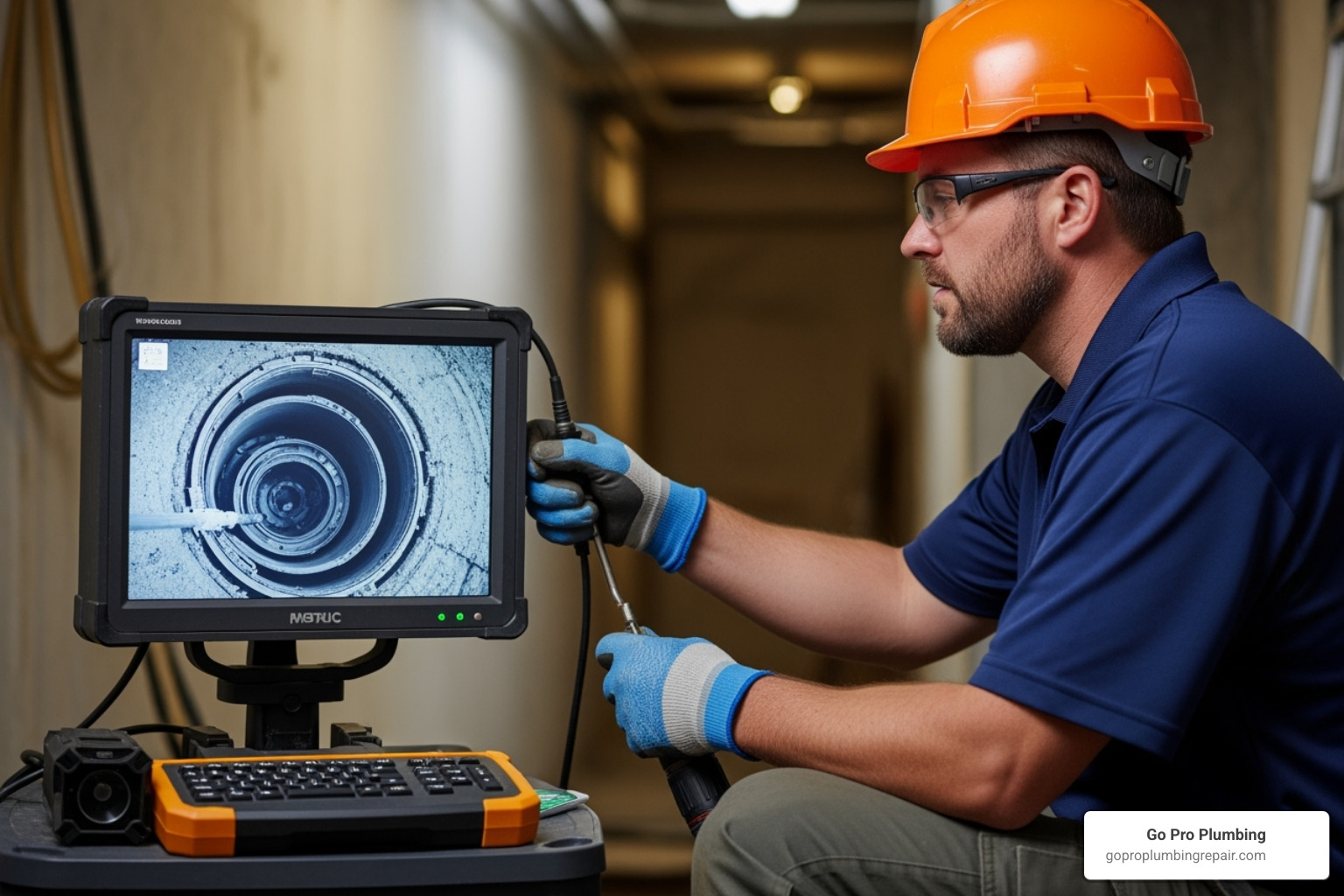
The good news? Modern plumbing technology gives us incredible tools to diagnose and fix these problems efficiently. While costs vary depending on what’s causing your sewage line clogged situation, investing in professional solutions now can save you thousands in potential damage later. For comprehensive help with any sewer line issues, we’re here to provide reliable Sewer Line Repair services.
How Professionals Clear a Sewage Line Clogged with Debris
We don’t attack the problem blindly. Our first move is a sewer camera inspection, sending a high-resolution camera through your pipes to see exactly what we’re dealing with. This allows us to pinpoint the clog’s location and cause—be it grease, wipes, or roots—and assess the overall condition of your pipes. Once we’ve diagnosed the issue, we choose the right tool. For most clogs, we use a heavy-duty mechanical auger (a professional-grade snake) to break apart or pull out the blockage. For more severe clogs, we use hydro-jetting. This process blasts high-pressure water (up to 4,000 PSI) through the line, scouring away buildup and slicing through roots. It leaves your pipes exceptionally clean, and you can learn more on our High Pressure Sewer Jetter page. If the camera reveals a crack or small break, we may be able to perform spot repairs, saving you the cost of a full replacement.
The Cost of Repairing a Sewage Line Clogged by Roots or Debris
Let’s talk numbers – we know this is probably what’s keeping you up at night. The cost of fixing a sewage line clogged problem varies quite a bit, but understanding the ranges can help you plan and make informed decisions.
For typical clearing jobs where we can solve the problem with snaking or hydro-jetting, you’re looking at $100 to $500. This covers most straightforward blockages that haven’t caused structural damage to your pipes. It’s the kind of fix that gets you back to normal life quickly without breaking the bank.
However, if your sewage line clogged because of broken pipes, extensive root damage, or severely deteriorated lines, we’re looking at repair or replacement costs between $1,200 and $6,000. We know that sounds like a wide range, but the final cost depends on several factors that we can’t predict until we’ve done our detective work.
When full or partial replacement is necessary, costs typically run $50 to $125 per foot of pipe. The variation depends on how deep we need to dig, what type of material we’re installing, and how difficult the excavation will be. A shallow line in soft soil costs less than a deep line under your concrete driveway.
Several factors influence the final price tag. Severe clogs cost more than simple blockages. Deep or hard-to-reach clogs require more time and specialized equipment. The type of solution needed makes a huge difference – clearing a clog is always less expensive than replacing damaged pipes. And accessibility matters too – if we need to dig up landscaping or concrete, that can add $1,000 or more to the project.
Here’s something important to know: most standard homeowner insurance policies won’t cover sewer line repairs or replacements. Insurance companies typically consider these maintenance issues rather than sudden disasters. This reality makes prevention even more valuable – it’s much cheaper to maintain your system than to replace it.
Proactive Prevention: How to Keep Your Drains Flowing
The best sewage line clogged emergency is the one that never happens. After years of pulling everything from tree roots to toy cars out of sewer lines, we’ve learned that most problems are completely preventable with the right habits.
Proper grease disposal is probably the most important change you can make. Never pour fats, oils, or grease down your kitchen drain, even if you run hot water afterward. Instead, let grease cool and solidify in an old coffee can or milk carton, then toss it in the trash. Your pipes will thank you for decades.
Installing drain strainers in all your sinks, showers, and tubs is like having tiny bodyguards protecting your pipes. These simple devices catch hair, food particles, and soap scum before they can start their journey toward your main line. Just remember to clean them regularly – a clogged strainer can’t do its job.
We cannot stress this enough: only flush toilet paper and human waste. We’ve pulled everything from entire packages of “flushable” wipes to small toys out of sewer lines. If it’s not toilet paper, it doesn’t belong in your toilet. Period.
Regular professional cleaning is like getting a physical for your plumbing system. We recommend having your sewer line inspected and cleaned every two years. This allows us to catch small problems before they become big, expensive emergencies. When you’re ready for maintenance, you can search Sewer Cleaning Near Me and find us ready to help.
Finally, tree root management is crucial, especially here in Northern California where mature landscaping is common. If you have large trees near your sewer line, consider annual inspections. When planting new trees, think about their mature root systems and plant them well away from your sewer lines. Your future self will appreciate the foresight.
Following these simple prevention strategies can save you from the stress, mess, and expense of a sewage line clogged emergency. Trust us – we’d rather help you prevent problems than clean up disasters, though we’re here for both.
Conclusion
A sewage line clogged emergency can feel overwhelming, but now you know the warning signs: multiple drains backing up, gurgling sounds, sewer odors, and soggy patches in your yard. The culprits are often everyday things like grease, “flushable” wipes, and invasive tree roots.
When disaster strikes, your response matters. Stop all water use immediately and call a professional. A main sewer line clog is not a DIY project due to serious health risks and the potential to make the problem worse.
Prevention is your best friend. Simple habits like proper grease disposal, using drain strainers, and only flushing toilet paper can save you thousands. Regular professional maintenance every couple of years is also key to catching problems early.
At Go Pro Plumbing, we help families across Northern California tackle these challenges. We know a sewage line clogged problem is urgent, which is why we’re committed to same-day service and outstanding customer care. Whether you’re in Rancho Cordova, Sacramento, or nearby, we’re here to help. Don’t let a sewer line problem turn your home upside down. Contact us for professional sewer line services – because some problems are just too important to handle alone.
